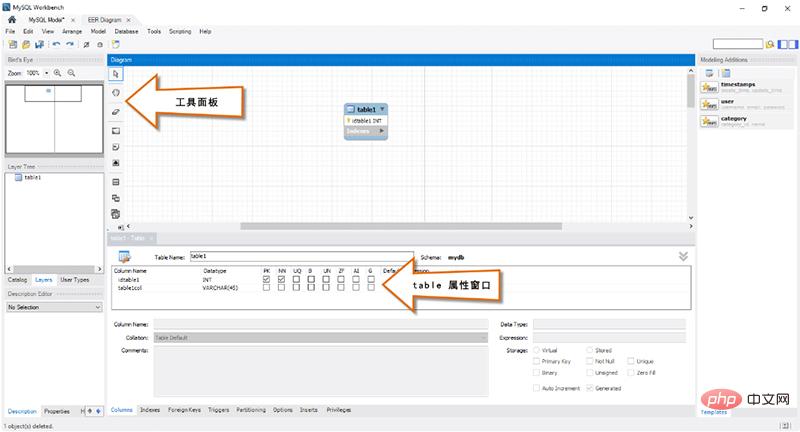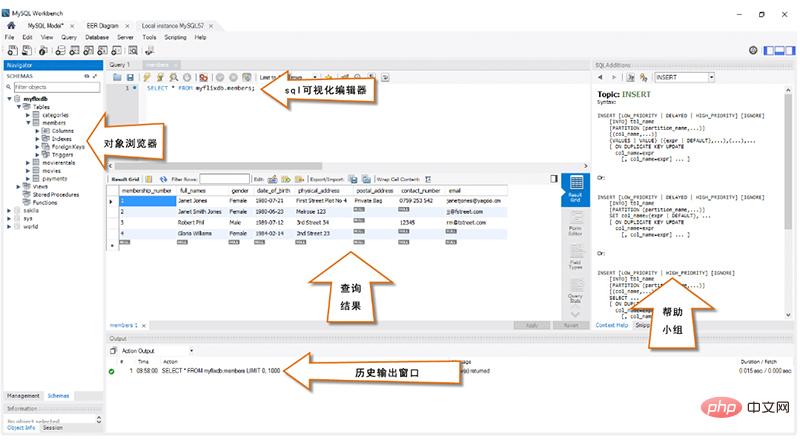what is mysql workbench
MySQL Workbench is an ER/database modeling tool specially designed for MySQL. It helps create new physical data models and modify existing MySQL databases with reverse/forward engineering and change management capabilities.

Recommended reference study: "mysql Tutorial"
MySQL Workbench - Modeling and Design Tool
1. Models are at the heart of most effective and performant databases. MySQL workbench has tools that allow developers and database administrators to visually create physical database design models that can be easily converted to MySQL databases using forward engineering.
2.MySQL Workbench supports creating multiple models in the same environment.
3. It supports all objects that make up the database, such as tables, views, stored procedures, triggers, etc.
4.MySQL workbench has a built-in model validation utility that can report any issues that may be found in the data modeler.
5. It also allows the use of different modeling symbols and can be extended using the LUA scripting language.
The modeling window of MySQL Workbench is as follows:

##MySQL Workbench - SQL Development Tools
Structured Query Language (SQL) allows us to manipulate relational databases. SQL is the core of all relational databases. 1.MySQLworkbench, built-in SQL visual editor. 2.Visual SQL Editor allows developers to build, edit and run queries against the MySQL server database. It has utilities for viewing and exporting data. 3. Its syntax color highlighting display helps developers easily write and debug SQL statements. 4. Multiple queries can be run and the results will be automatically displayed in different tabs. 5. The query is also saved in the history panel for later retrieval and running.The SQL development window of MySQL Workbench is as follows:

Server management plays a key role in protecting company data. The main issues regarding server management are user management, server configuration, server logs, etc. Workbench MySQL has the following features to simplify the process of MySQL server management;
1. User Management- A visual utility for managing users, allowing database administrators to easily add new ones when needed Users and delete existing users, grant and remove permissions and view user profiles.
2. Server Configuration- Allows advanced configuration of the server and fine-tuning for optimal performance.
3. Database Backup and Recovery- Visual tool for exporting/importing MySQL dump files. MySQL dump files contain SQL scripts used to create databases, tables, views, stored procedures and data insertion.
4. Server log- Visual tool for viewing MySQL server logs. Logs include error logs, binary logs and InnodDB logs. These logs come in handy when performing diagnostics on the server.
Workbench The Admin management operation panel of MySQL is as follows:
 This article is an introduction to mysql workbench. I hope it will be helpful to those who need it. Friends help!
This article is an introduction to mysql workbench. I hope it will be helpful to those who need it. Friends help!
The above is the detailed content of what is mysql workbench. For more information, please follow other related articles on the PHP Chinese website!

Hot AI Tools

Undresser.AI Undress
AI-powered app for creating realistic nude photos

AI Clothes Remover
Online AI tool for removing clothes from photos.

Undress AI Tool
Undress images for free

Clothoff.io
AI clothes remover

Video Face Swap
Swap faces in any video effortlessly with our completely free AI face swap tool!

Hot Article

Hot Tools

Notepad++7.3.1
Easy-to-use and free code editor

SublimeText3 Chinese version
Chinese version, very easy to use

Zend Studio 13.0.1
Powerful PHP integrated development environment

Dreamweaver CS6
Visual web development tools

SublimeText3 Mac version
God-level code editing software (SublimeText3)

Hot Topics
 1389
1389
 52
52
 When might a full table scan be faster than using an index in MySQL?
Apr 09, 2025 am 12:05 AM
When might a full table scan be faster than using an index in MySQL?
Apr 09, 2025 am 12:05 AM
Full table scanning may be faster in MySQL than using indexes. Specific cases include: 1) the data volume is small; 2) when the query returns a large amount of data; 3) when the index column is not highly selective; 4) when the complex query. By analyzing query plans, optimizing indexes, avoiding over-index and regularly maintaining tables, you can make the best choices in practical applications.
 Can I install mysql on Windows 7
Apr 08, 2025 pm 03:21 PM
Can I install mysql on Windows 7
Apr 08, 2025 pm 03:21 PM
Yes, MySQL can be installed on Windows 7, and although Microsoft has stopped supporting Windows 7, MySQL is still compatible with it. However, the following points should be noted during the installation process: Download the MySQL installer for Windows. Select the appropriate version of MySQL (community or enterprise). Select the appropriate installation directory and character set during the installation process. Set the root user password and keep it properly. Connect to the database for testing. Note the compatibility and security issues on Windows 7, and it is recommended to upgrade to a supported operating system.
 Explain InnoDB Full-Text Search capabilities.
Apr 02, 2025 pm 06:09 PM
Explain InnoDB Full-Text Search capabilities.
Apr 02, 2025 pm 06:09 PM
InnoDB's full-text search capabilities are very powerful, which can significantly improve database query efficiency and ability to process large amounts of text data. 1) InnoDB implements full-text search through inverted indexing, supporting basic and advanced search queries. 2) Use MATCH and AGAINST keywords to search, support Boolean mode and phrase search. 3) Optimization methods include using word segmentation technology, periodic rebuilding of indexes and adjusting cache size to improve performance and accuracy.
 Difference between clustered index and non-clustered index (secondary index) in InnoDB.
Apr 02, 2025 pm 06:25 PM
Difference between clustered index and non-clustered index (secondary index) in InnoDB.
Apr 02, 2025 pm 06:25 PM
The difference between clustered index and non-clustered index is: 1. Clustered index stores data rows in the index structure, which is suitable for querying by primary key and range. 2. The non-clustered index stores index key values and pointers to data rows, and is suitable for non-primary key column queries.
 MySQL: Simple Concepts for Easy Learning
Apr 10, 2025 am 09:29 AM
MySQL: Simple Concepts for Easy Learning
Apr 10, 2025 am 09:29 AM
MySQL is an open source relational database management system. 1) Create database and tables: Use the CREATEDATABASE and CREATETABLE commands. 2) Basic operations: INSERT, UPDATE, DELETE and SELECT. 3) Advanced operations: JOIN, subquery and transaction processing. 4) Debugging skills: Check syntax, data type and permissions. 5) Optimization suggestions: Use indexes, avoid SELECT* and use transactions.
 The relationship between mysql user and database
Apr 08, 2025 pm 07:15 PM
The relationship between mysql user and database
Apr 08, 2025 pm 07:15 PM
In MySQL database, the relationship between the user and the database is defined by permissions and tables. The user has a username and password to access the database. Permissions are granted through the GRANT command, while the table is created by the CREATE TABLE command. To establish a relationship between a user and a database, you need to create a database, create a user, and then grant permissions.
 Explain different types of MySQL indexes (B-Tree, Hash, Full-text, Spatial).
Apr 02, 2025 pm 07:05 PM
Explain different types of MySQL indexes (B-Tree, Hash, Full-text, Spatial).
Apr 02, 2025 pm 07:05 PM
MySQL supports four index types: B-Tree, Hash, Full-text, and Spatial. 1.B-Tree index is suitable for equal value search, range query and sorting. 2. Hash index is suitable for equal value searches, but does not support range query and sorting. 3. Full-text index is used for full-text search and is suitable for processing large amounts of text data. 4. Spatial index is used for geospatial data query and is suitable for GIS applications.
 RDS MySQL integration with Redshift zero ETL
Apr 08, 2025 pm 07:06 PM
RDS MySQL integration with Redshift zero ETL
Apr 08, 2025 pm 07:06 PM
Data Integration Simplification: AmazonRDSMySQL and Redshift's zero ETL integration Efficient data integration is at the heart of a data-driven organization. Traditional ETL (extract, convert, load) processes are complex and time-consuming, especially when integrating databases (such as AmazonRDSMySQL) with data warehouses (such as Redshift). However, AWS provides zero ETL integration solutions that have completely changed this situation, providing a simplified, near-real-time solution for data migration from RDSMySQL to Redshift. This article will dive into RDSMySQL zero ETL integration with Redshift, explaining how it works and the advantages it brings to data engineers and developers.




